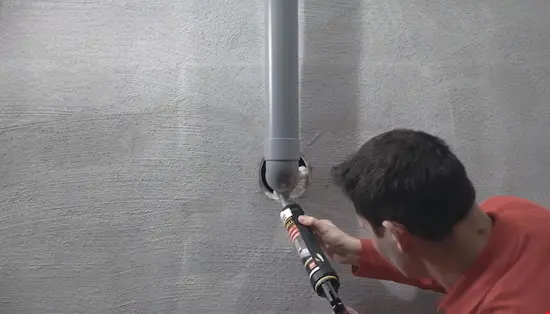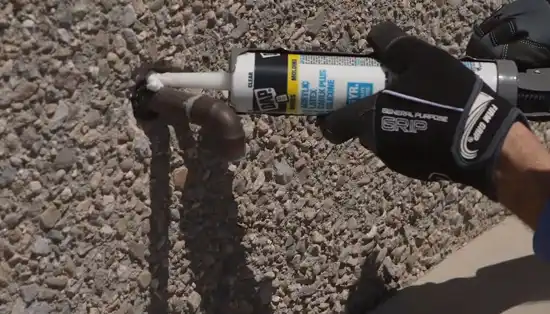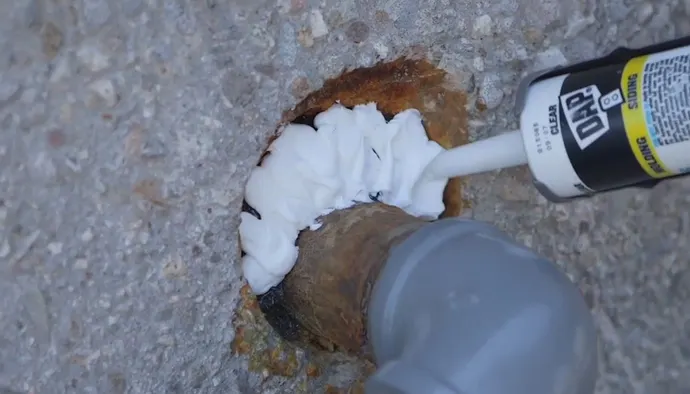Last Updated on January 11, 2023
There are several methods that can be used to seal a pipe through concrete. These methods include the use of Polyurethane foam, Compression Discs, and silicone adhesives.
How to Seal a Pipe Through Concrete: 5 Methods
Each method has its pros and cons. If you’re unsure of which method to use, consider these steps.
Polyurethane foam
Polyurethane foam is a type of sealant that can be used to repair a water leak in concrete. The foam goes in as a liquid, expands and fills the space around the leaking pipe, and binds tightly to the concrete.
This helps prevent water from getting into the pipe and causes the leak to stop. It also helps to protect the surrounding area from damage by keeping it dry.
Polyurethane foam has an expanding property, which means that it expands and cures quickly. To increase the rate of expansion, misting the area before applying the foam will help speed up the process.
However, you should be careful not to over-mist the area as the foam will not stick to the wet surface.
The foam is also hydrophobic, so it will harden if it comes into contact with water. By contrast, mudjacking slurry is not waterproof, and it will wash away if it comes in contact with water.
This may happen if the sewer pipe breaks or poor grading causes the soil to wash away from the slab.
Because polyurethane cures quickly, it is ideal for infrastructure repairs. The material is highly durable, water repellent, and lightweight. In addition to repairing pipes, polyurethane foam can treat leaks in box culverts.
It can also help prevent water from entering pump stations, utility boxes, and wet wells. Moreover, it is a cost-effective option for sewer infrastructure repair.
To create polyurethane foam, you need to mix a two-part solution. Part A is a chemical called MDI, while part B is a mixture of polyols, catalysts, and blowing agents.
The two-part solution is then mixed together with an impingement gun and injected into the voids around the asset in question. For deeper or larger voids, you can use a tube to inject the material into the space.
Compression Disc
When multiple pipes need to be sealed in one opening, a compression disc seal is the best option. These seals can be used for a wide variety of applications, including water and wastewater pipes.
Compression disc seals can also be used in areas where there is a large annular space or a core hole too small for other types of pipe seals. They are available in split and modular models.
Caulk
Using caulk to seal a pipe through concrete is an excellent way to prevent water damage. It works as a concrete expansion joint sealant and will keep water out while protecting the foundation and walkways.
You can apply urethane caulk to the pipe by cutting an opening with a sharp knife about 30 degrees larger than the pipe gap. Once the caulk has been applied, use a spoon to smooth out the edges. For best results, use a spoon that’s been soaked in mineral spirits before you start.
To seal a pipe through concrete, you need to make an opening that is one half-inch wide by one-half-inch deep. After applying the caulk, use a hand-held duster or an old paintbrush to remove dust from around the pipe.
Next, use a small trowel to pack the hydraulic cement into the opening. Make sure that it connects with the pipe and the surrounding wall. If the gap is larger than half-inch wide, apply cement to fill it.
If you’ve never used caulk before, it might be difficult to get a smooth finish. Fortunately, there are a few different types available that can help you get the job done.
First, you should choose a type of caulking based on the pipe size. If the gap is smaller than a half-inch wide, use a silicone-based or acrylic caulk.
If you’re not confident with the process, you can use a hydroactive sealant like SwellCaulk. This kind of caulk swells up and contracts as it gets in contact with water. The resulting polyurethane gel will prevent water from working its way through the crack.
Silicone adhesives

One of the main questions asked by manufacturers of silicone adhesives is how to remove the sealant. While these adhesives are extremely versatile, you need to keep in mind that they require a curing period.
This can range from 24 hours to several days. For this reason, you should always use a well-ventilated area when working with silicone.
Silicone adhesives are made by isolating silica, a mineral present in many minerals. Silicon is a relatively difficult element to separate because of its high melting point, which makes it difficult to extract in its natural form.
A quartz ore is typically used as the base material, and the resulting silica sand is crushed down to a size of about 25mm and screened to remove any impurities.
Silicone adhesives are also available in single and two part formulations. The main difference between the two types is that one part is applied directly to the surface.
The other part is applied to the pipe, and a silicone sealant forms a durable, flexible bond. This makes silicone a very flexible product and the perfect choice for joining wood and metal.
Silicone adhesives are great for sealing bonds exposed to atmospheric moisture and water. Loctite Plumber and Marine Clear Adhesive is a highly versatile silicone that can be applied thickly to create a water-tight seal.
Loctite Polyseamseal Acrylic Caulk with Silicone is an acrylic-based caulk that bonds to metals and wood.
Another good choice is Concrete Silicone 2. This product is 100% silicone and is water-proof. It also adheres to most surfaces.
Epoxy sealant
One of the best ways to seal a pipe is with an epoxy sealant. This type of sealant is much stronger than cement or caulk and can be applied in small cracks. The problem with epoxy is that it dries slowly and can run out the other side of a crack. Also, it will not work on wet surfaces.
Unlike polyurethane, epoxy cannot be used to fill expansion joints in newly-poured concrete. This is because epoxy cannot bond with moving or wet concrete. Also, you would need to use a special product if you are going to use it in cold climates.
Another problem with epoxy is that some crack fillers are not meant for concrete. Good-Bye Cracks, for example, is designed to be applied to wood, drywall, and plaster, but it will not bond to concrete.
Another type of epoxy sealant is plumber’s epoxy, which is applied with a duct tape or dry cloth. Some plumbers also use a propane torch to accelerate the process. These products can be applied in five minutes or less. To make it faster, you can buy it in bulk.
Epoxy Waterproofer is a thick, thermosetting epoxy that hardens to a clear ceramic-like film. Because it is watertight, it is ideal for lining tanks and utility ducts. It can also be used to seal off leaks in below-grade basement walls.
Is it possible to completely seal a pipe going through concrete?
There are a few ways to do this. One is by using a liquid epoxy that is applied to the outside of the pipe and then sealed with concrete. Another way is to use a sleeve that is placed over the pipe and then sealed with concrete.
Either way, it’s important that the sealant be applied properly so that there are no cracks or gaps through which water can seep.
What are the benefits of sealing a pipe through concrete?

Sealing a pipe through concrete can provide a number of benefits, including:
– decreased water leakage
– prevention of corrosion and rusting of the pipes
– reduced noise levels as a result of running water
– protection against unauthorized access to the pipes
Is there anything else someone should know before sealing a pipe through concrete?
There are a few things to be aware of when sealing a pipe through concrete. First, you’ll need to choose the right sealant. There are many different types available, so be sure to select one that is specifically designed for use with concrete.
You’ll also need to make sure the surface of the concrete is clean and dry before applying the sealant. If there is any dirt or moisture present, it will prevent the sealant from adhering properly and could cause it to fail.
Finally, be sure to allow plenty of time for the sealant to cure before using the pipe again. Depending on the type you choose, curing times can range from several hours to several days.



